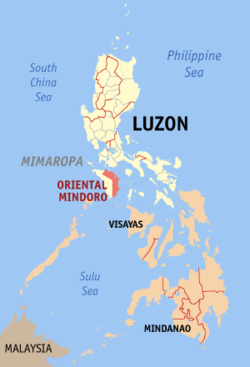Mindoro Oriental
| Oriental Mindoro | |||
|---|---|---|---|
| Province | |||
| Province of Oriental Mindoro | |||
|
|||
 Location in the Philippines |
|||
| Coordinates: 13°00′N 121°25′E / 13°N 121.42°ECoordinates: 13°00′N 121°25′E / 13°N 121.42°E | |||
| Country | Philippines | ||
| Region | Mimaropa (Region IV-B) | ||
| Founded | 1955 | ||
| Capital | Calapan | ||
| Government | |||
| • Type | Sangguniang Panlalawigan | ||
| • Governor | Alfonso Umali, Jr. (Liberal) | ||
| • Vice Governor | Humerlito "Bonz" Dolor (Liberal) | ||
| Area | |||
| • Total | 4,238.38 km2 (1,636.45 sq mi) | ||
| Area rank | 28th out of 81 | ||
| Highest elevation (Mount Halcon) | 2,586 m (8,484 ft) | ||
| Population (2015 census) | |||
| • Total | 844,059 | ||
| • Rank | 32nd out of 81 | ||
| • Density | 200/km2 (520/sq mi) | ||
| • Density rank | 47th out of 81 | ||
| Divisions | |||
| • Independent cities | 0 | ||
| • Component cities |
1
|
||
| • Municipalities | |||
| • Barangays | 426 | ||
| • Districts | 1st and 2nd districts of Oriental Mindoro | ||
| Time zone | PHT (UTC+8) | ||
| ZIP code | 5200–5214 | ||
| IDD : area code | +63 (0)43 | ||
| ISO 3166 code | PH-MDR | ||
| Spoken languages | |||
| Website | www |
||
Oriental Mindoro (Tagalog: Silangang Mindoro, Spanish: Mindoro Oriental) is a province in the Philippines located in the island of Mindoro under Mimaropa region in Luzon, about 140 kilometres (87 mi) southwest of Manila. The province is bordered by the Verde Island Passage and the rest of Batangas to the north, by Marinduque, Maestre de Campo (or known as Sibale but official name is Concepcion) Island, Tablas Strait and the rest of Romblon to the east, by Semirara and the rest of Caluya Islands, Antique to the south, and by Occidental Mindoro to the west. Calapan, the only city in the island, is the provincial capital.
Oriental Mindoro is touted as the country's emerging eco-tourism destination. In 2005, the Philippines was found to be the center of marine fish biodiversity and the home of the most diverse marine ecosystem in the world, by American biologists Kent Carpenter and Victor Springer. Most of the endemic species in the Philippines are found in the Verde Island Passage between Mindoro island and the main island of Luzon. The passage houses 2,983 individual species of algae, corals, crustaceans, mollusks, fishes, marine reptiles, and marine mammals, based on a study conducted by Carpenter and Springer in 2005.
UNESCO declared Puerto Galera a biosphere reserve under its Man and the Biosphere Programme in the 1970s. The Verde Island Passage is at the apex of the so-called Coral Triangle – the Philippines, Indonesia, and Malaysia – which has the distinction of being the "global center of marine biodiversity".
...
Wikipedia


